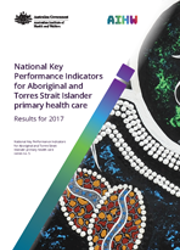Summary
This is the fifth national report on the Indigenous primary health care national Key Performance Indicators (nKPIs) data collection. It presents data on all 24 nKPI indicators for the first time.
Data for this collection are provided to the Australian Institute of Health and Welfare (AIHW) by primary health care organisations that receive funding from the Australian Government Department of Health to provide services to Aboriginal and Torres Strait Islander people. Some primary health care organisations included in the collection receive additional funding from other sources, including state and territory health departments.
As of the June 2017 data collection, changes have been made to the data extraction method, with the Department of Health introducing a new direct load reporting process. This allowed Communicare, Medical Director, and Primary Care Information System (PCIS) clinical information systems (CISs) to generate nKPI data within their clinical system, and transmit directly to the OCHREStreams portal. Best Practice services were provided with an interim tool while MMEx has always had direct load capability.
The new process was introduced to provide a greater level of consistency between CISs, but the change in the extraction method means that data from June 2017 onwards are not comparable with earlier collections.
As the June 2017 collection represents a new baseline for the collection, this report only presents data for June and December 2017.
For 2 indicators (Kidney function tests recorded and Kidney function test results) only December 2017 results are presented due to unresolved data quality issues in June 2017.
See Chapter 2 for more information on the change in extraction method, data quality, and the impact on the collection, and Appendix E for data improvement projects and the nKPI/Online Service Reporting (OSR) review under way.
Improvements were seen for most indicators between June and December 2017. Although data from these 2 reporting periods are not comparable with earlier reporting periods, an overall pattern of improvement is in keeping with the pattern of improvement previously reported for the period June 2012 to May 2015 (see AIHW 2017). This indicates that health organisations continue to show progress in service provision.
The good news
Between June and December 2017, improvements were seen in 16 out of a possible 23 measures for which comparable data for both periods were available (see Table S1 for details). Results for a further indicator remained stable between reporting periods.
The improvements were seen in 12 of the 15 process-of-care measures with comparable data. Improvements were also seen in 4 of the 8 outcome measures, while 1 outcome measure remained stable. The largest improvements (4 or 5 percentage points) were seen in the recording practices for the measuring of:
- influenza immunisations for clients with type 2 diabetes, which rose from 31% to 36%
- influenza immunisations for clients with chronic obstructive pulmonary disease (COPD), which rose from 32% to 37%
- influenza immunisations for clients aged 50 and over, which rose from 32% to 36%.
Things to work on
For the 3 process-of-care indicators that did not show improvements—glycated haemoglobin (HbA1c) result recorded (6 months), cervical screening, and Medicare Benefits Schedule (MBS) health assessment for those aged 0–4—the changes were very small (0.5, 0.4, and 0.1 percentage points, respectively).
In the case of cervical screening, this might be due to changes to the cervical screening program, which took effect from 1 December 2017 (see Chapter 4 for details).
Three outcome measures that did not show improvements—HbA1c result of 7% or less, low birthweight, and smoking status of women who gave birth in the previous 12 months—saw changes of between 0.8 and 1.8 percentage points.
Preliminary material: Acknowledgments; Abbreviations; Symbols
1. Introduction
- The nKPI collection
- Structure of this report
2. Data quality
- Data quality issues
- Additional considerations for interpreting nKPI data
3. Maternal and child health indicators
Why are these indicators important?
- First antenatal visit
- Birthweight recorded
- MBS health assessment (item 715) for children aged 0–4
- Child immunisation
- Birthweight result
- Smoking status of females who gave birth within the previous 12 months
4. Preventative health indicators
Why are these important?
- Smoking status recorded
- Alcohol consumption recorded
- MBS health assessment (item 715) for adults aged 25 and over
- Risk factors assessed to enable cardiovascular disease (CVD) risk assessment
- Cervical screening
- Immunised against influenza-Indigenous regular clients aged 50 and over
- Smoking status result
- Body mass index classified as overweight or obese
- AUDIT-C result
- Cardiovascular disease risk assessment result
5. Chronic disease management indicators
Why are these important?
- General Practitioner Management Plan-clients with type 2 diabetes
- Team Care Arrangement-clients with type 2 diabetes
- Blood pressure result recorded-clients with type 2 diabetes
- HbA1c result recorded-clients with type 2 diabetes
- Kidney function test recorded-clients with type 2 diabetes
- Kidney function test recorded-clients with cardiovascular disease
- Immunised against influenza-clients with type 2 diabetes
- Immunised against influenza-clients with chronic obstructive pulmonary disease
- Blood pressure result-clients with type 2 diabetes
- HbA1c result-clients with type 2 diabetes
- Kidney function test result-clients with type 2 diabetes-eGFR
- Kidney function test result-clients with type 2 diabetes-ACR
- Kidney function test result-clients with cardiovascular disease-eGFR
6. Discussion
Data improvements
Appendixes:
Appendix A: Background to the nKPI collection and indicator technical specifications
Appendix B: Data completeness
Appendix C: Comparison of nKPI results
Appendix D: State and territory and remoteness variation figures
Appendix E: Data improvement projects
Appendix F: Guide to the figures
End matter: Glossary; References



